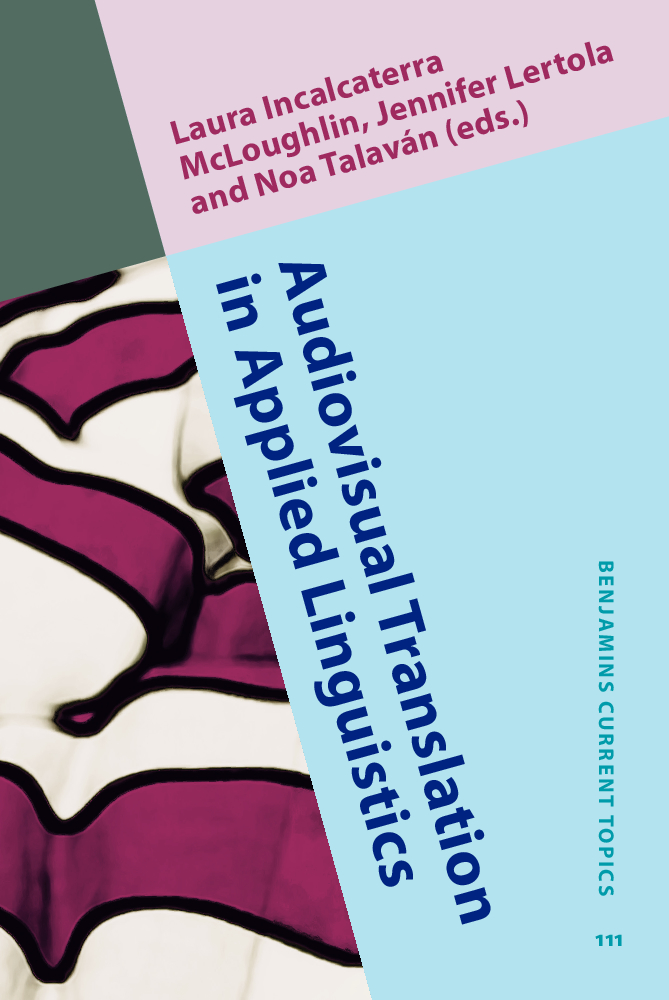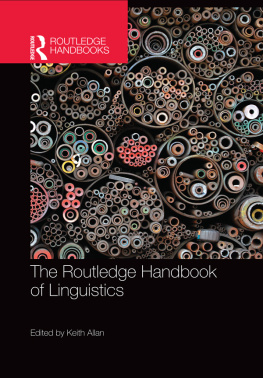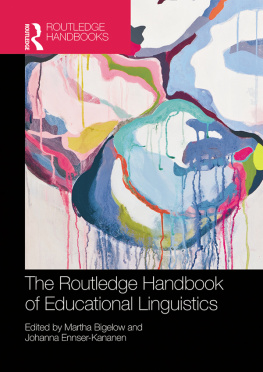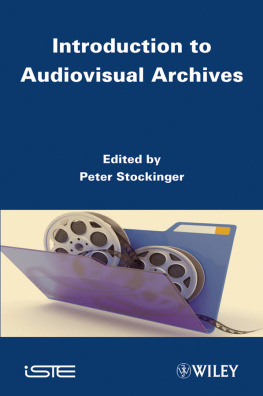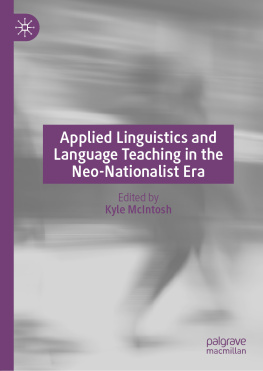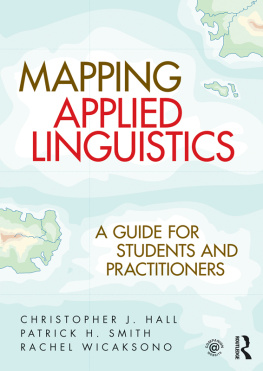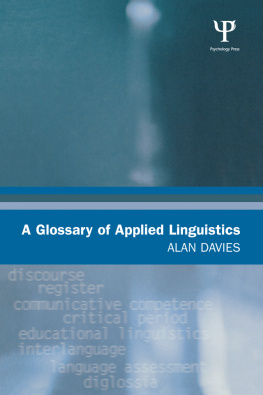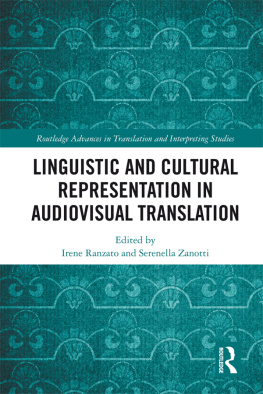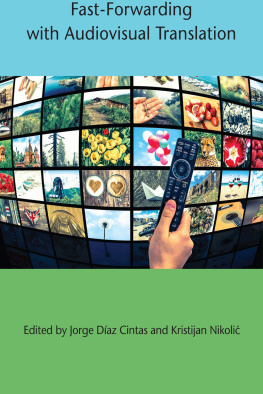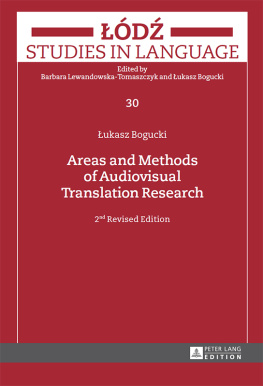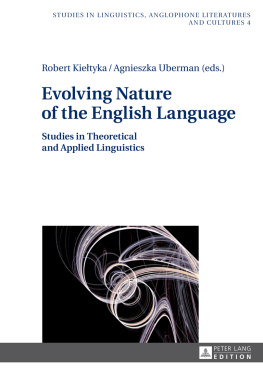Laura Incalcaterra McLoughlin , Jennifer Lertola & Noa Talavn National University of Ireland, Galway | Universit del Piemonte Orientale | Universidad Nacional de Educacin a Distancia
No part of this book may be reproduced in any form, by print, photoprint, microfilm, or any other means, without written permission from the publisher.
Laura Incalcaterra McLoughlin , Jennifer Lertola and Noa Talavn National University of Ireland, Galway | Universit del Piemonte Orientale | Universidad Nacional de Educacin a Distancia
In recent years, interest in the application of audiovisual translation (AVT) techniques in language teaching has grown beyond unconnected case studies to create a lively network of methodological intertextuality, cross-references, reviews and continuation of previous trials, ultimately defining a recognisable and scalable trend. This volume presents a sample of the current research in this field, with particular reference to case studies that either have a large-scale or international dimension, or can be scaled and replicated with different languages, at different fluency levels and in different contexts. It is our hope that these debates, studies and proposals may arouse the interest of publishers of language learning material and other stakeholders and ultimately lead to the mainstreaming of AVT in language education.
The use of AVT in language teaching is not new: subtitles as a support in particular (both interlingual and intralingual) have been utilised extensively for decades, both in teacher-led and in independent learning contexts. Studies on the impact of the subtitles on language learners go back to the late 1980s. Indeed ). These studies concentrate on ready-made audiovisual translations: the standard (L2 audio and L1 written text) or reversed (L1 audio and L2 written text) interlingual subtitled version of a video was shown and complemented with a number of additional activities. This volume however also looks at a different application of AVT, in which learners are involved in the audiovisual translation process itself, performing tasks such as subtitling, dubbing, or audio describing.
This different methodological and operational approach exploits a combination of receptive and productive tasks, facilitating meaningful interaction in the target language. In this context, learners are asked to view the audiovisual text and then translate (or create) the verbal soundtrack in form of subtitles, dubbing, audio description, voice narration, etc. Early proposals of the potential of this methodology date back to the late 1980s for both dubbing (; among others).
Generally speaking, teachers and researchers who work on active AVT tasks with their students found that they encourage not only receptive and productive tasks, but also critical thinking, pragmatic and intercultural awareness both in L1 and L2, as well as the ability to extract and infer information from multisemiotic texts. And in the future, it may be useful to focus also on the relationship between active AVT tasks and the enhancement of digital literacies in language learners, for example by linking tasks to critical use of online translators, prompting comparisons and appraisals of different AVT versions of the same product whether available on the market or taken from a student corpus or encouraging the use of online corpora, and so on.
Whilst subtitling has undoubtedly received most attention, possibly thanks to the availability of free and user-friendly subtitling software (). The potential for future developments is significant, especially if researchers from accessibility studies, AVT and Applied Linguistics worked together towards new language learning frontiers.
From a theoretical point of view, Paivios Dual Coding theory (:39) and is part of the enactive level (the level of doing), where different senses are employed, and retention is more effective. Multisensory and intersemiotic experiences, therefore, have a stronger impact on cognitive processes than those relying on just one sense or one semiotic channel. The research and case studies presented in this volume show that AVT can provide such direct experiences: learners watch, listen, read, translate, manipulate, react and re-enact communication events observed (or better, experienced) in their linguistic and extra-linguistic contexts. It is this doing, researchers agree, that makes deep learning possible.
Perhaps one element that has been underestimated so far to a certain extent is the way that AVT tasks can help to develop the so-called 21st Century Skills, yet the combination of software use, teamwork, analysis, creation and evaluation of contextualised and purposeful speech acts facilitates the acquisition of new and essential skills. The Framework for 21st Century Learning (Partnership for 21st Century Learning 2007) They are creativity, critical thinking, communication and collaboration and are all required for the completion of a successful AVT task. Equally important is the ability to understand, contribute to and evaluate media environments, to utilise technology, select and analyse information. All aspects that form part of any type of AVT task.
This volume presents contributions from mainly new voices in AVT research, who discuss innovative approaches and recent case studies.
Valentina Ragni explores subtitle creation as a foreign language learning tool. Ragni, who refers to the creation of subtitles as didactic subtitling, acknowledges the studies on subtitling and draws attention to the need for a clearer theoretical framework to support subtitling activities. She reviews a number of theories from Second Language Acquisition (SLA) literature that underpin interlingual subtitling in foreign language learning. After examining how subtitling can be applied within Task-based Learning and Teaching (TBLT), she argues for the integration of didactic subtitling and Form-Focused Instruction (FFI). The author acknowledges that it can be challenging moving from theoretical considerations to real-world applications and encourages further investigation on the topic.
Carmen Herrero and Manuela Escobar encourage the integration of Film Literacy Education and audio description in the foreign language curriculum. In the context of Spanish as a Foreign Language in Higher Education, the authors propose a pedagogical model designed to assist learners in developing linguistic as well as cultural and intercultural competences, while fostering critical understanding of the aesthetic dimension of films. Based on two case studies carried out in the UK, the model is developed in three sessions: introduction to film language and critical thinking; focus on a Spanish director and selected movie in this case Pedro Almodvar and his movie based on the story of a visually-impaired filmmaker, so as to relate to the accessibility issue and finally, audio description task performance.
Anca Frumuselu considers the pedagogical use of subtitled and captioned material in the foreign language classroom by reviewing relevant theories such as Cognitive Load Theory (CLT), Cognitive Theory of Multimedia Learning (CTML) and Cognitive Affective Theory of Learning with Media (CATLM), which reveal the cognitive processing activated when students are exposed to multimedia and subtitled audiovisual materials. Frumuselu presents the results of two empirical studies showing the benefits of using interlingual (L1) and intralingual (L2) subtitles in the English as a Foreign Language (EFL) classroom in Higher Education for informal and colloquial language learning in this context.
